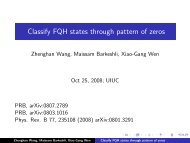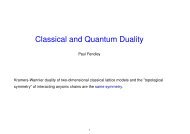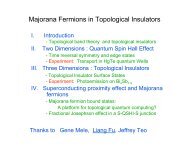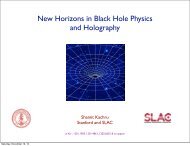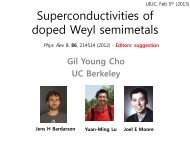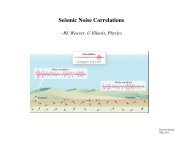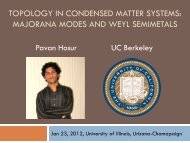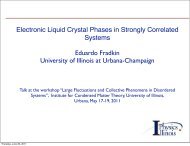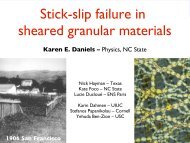Yiming Zhang Department of Physics, Harvard University
Yiming Zhang Department of Physics, Harvard University
Yiming Zhang Department of Physics, Harvard University
You also want an ePaper? Increase the reach of your titles
YUMPU automatically turns print PDFs into web optimized ePapers that Google loves.
<strong>Yiming</strong> <strong>Zhang</strong><br />
<strong>Department</strong> <strong>of</strong> <strong>Physics</strong>, <strong>Harvard</strong> <strong>University</strong><br />
Collaborators:<br />
Ak Acknowledgement: ld Douglas T. McClure (<strong>Harvard</strong>)<br />
Charles M. Marcus (<strong>Harvard</strong>)<br />
Loren N. Pfeiffer (Bell Labs)<br />
Ken W. West (Bell Labs)<br />
Bernd Rosenow (<strong>Harvard</strong>, MPG)<br />
Bert I. Halperin (<strong>Harvard</strong>)<br />
Eli Levenson‐Falk (<strong>Harvard</strong>, U. C. Berkley)<br />
Jeffery B. Miller (<strong>Harvard</strong>)<br />
Iuliana P. Radu (MIT)<br />
Marc A. Kastner (MIT)<br />
Workshop on Topological Phases in Condensed Matter, UIUC ‐ October 24‐26, 2008
Motivation<br />
• In 2D, clockwise exchange and counter‐clockwise<br />
exchange are distinct, leading to Anyonic statistics:<br />
Therefore, can be any value, hence called Anyons<br />
• Fractional statistics may show up in the FQHE regime:<br />
Ex. 1/3, 2/5, etc.<br />
• Non‐Abelian statistics is also possible in 2D, and may be<br />
found in some FQHE states: Ex. 5/2, 12/5<br />
• Proposed experiments to detect fractional/non‐Abelian<br />
statistics have made use <strong>of</strong> Fabry‐Perot interferometers
Motivation<br />
• Fabry‐Perot interferometer in QH regime<br />
Bonderson, et al., PRL 97, 016401 (2006)
Motivation<br />
• For detecting fractional statistics<br />
• At constant density: ,<br />
• At constant filling factor: ,
Motivation<br />
• For detecting non‐Abelian statistics<br />
• Odd number <strong>of</strong> quasi‐particles inside: no interference<br />
• Even number <strong>of</strong> quasi‐particles inside: has interference
Measurement Setup
Data ‐ 2 μmm 2 device
Data ‐ 2 μmm 2 device
Data ‐ 2 μmm 2 device
Data ‐ 2 μmm 2 device
Data ‐ 2 μmm 2 device
Previous Experiments<br />
ΔB = 2.5 mT<br />
ΔB = 2.7 mT<br />
ΔB = 5.3 mT
Previous Experiments<br />
Device diameter: 2.1 μm<br />
Camino, et al., PRB 76, 155305 (2007)<br />
Device diameter: 1.2 μm<br />
Godfrey, et al., arXiv: 0708.2448v1
Model – Coulomb blockade
Model – Coulomb blockade<br />
• Charging Energy:<br />
• Due to Coulomb blockade, N is an integer<br />
• Expect: and<br />
• In excellent agreement with experiments
Data ‐ 18 μmm 2 device
Data ‐ 18 μmm 2 device
Interpretation – AB Interference<br />
• The Aharonov‐Bohm phase is given by:<br />
where<br />
• Therefore,<br />
• With constant area:<br />
• With constant B:<br />
Assuming :
Comparison Between CB and AB<br />
Coulomb blockade<br />
Aharonov‐Bohm Interference
Comparison Between CB and AB<br />
Coulomb blockade<br />
Aharonov‐Bohm Interference
Comparison Between CB and AB<br />
There is one more predicted difference between them<br />
• Recall for CB:<br />
Therefore,<br />
• For AB: , and<br />
Therefore,
Comparion Between CB and AB<br />
Measure in a 2D plane <strong>of</strong> B and V C<br />
Coulomb blockade<br />
Aharonov‐Bohm Interference
Previous Experiment in FQHE
Previous Experiment in FQHE
Previous Experiment in FQHE<br />
At least two other possible interpretations: p<br />
• Integer Aharonov‐Bohm interference<br />
• Coulomb blockade for 1/3 quasi‐particles<br />
For and , also expect:<br />
Need to know which type <strong>of</strong> oscillation here
Non‐linear Regime<br />
The 18 μm 2 device: checkerboard pattern
Non‐linear Regime
Non‐linear Regime<br />
Data<br />
Model
Non‐linear Regime<br />
Add damping at high‐bias:<br />
Data<br />
Model
Non‐linear Regime
Non‐linear Regime<br />
The simple model for velocity has considered<br />
only two limits:<br />
• In the high‐field limit, cyclotron radius is much<br />
smaller than the confining potential variation, thus<br />
edge velocity is the drift velocity:<br />
• In the low‐field limit, model the confining potential as<br />
hard wall, edge velocity is skipping‐orbit velocity:
Non‐linear Regime<br />
The damping factor α:<br />
Model?
Non‐linear Regime<br />
The 2 μmm 2 device: diamond pattern
Conclusion



